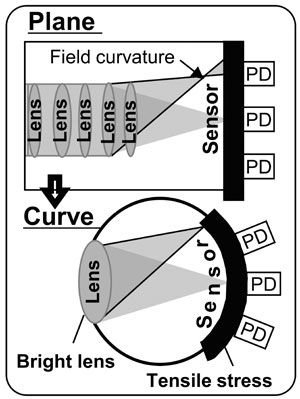nagi603
Forum Enthusiast
Actually, that image supports what I said: the curved sensor is only useful for the lenses that have a curved focal plane, either by being designed explicitly for the curved sensor, or e.g. being a cheap lens where only the central performance was deemed important as a cost saving measure.Perhaps not?Uh, I might not be right here, but to actually utilize a curved sensor, you might also need redesigned lenses. At least those which focus to the non-curved plane sensor. So not gonna happen.
- No curved sensor (would a future model gain a lot, e.g. corner performance?)
http://spectrum.ieee.org/tech-talk/...reates-curved-cmos-sensors-that-mimic-the-eye

Edge/corner improvement on current 'fabled' lenses?

Curved sensor realization?
This is not true for all lenses, however. Normally, engineers have to deal with this and design optics around it, at least partially. This is what causes a wavy field curvature that can be seen on quite a lot of MFT graphs. Do note that if these lenses would be used with a curved sensor, the resultant sharpness can even decrease due to these very corrections. If however, you have a lens that does not have these corrections, the result could be better IQ. Note, however, that many high-end lenses do incorporate these corrections.
Try to imagine the curvature of the sensor over an MTF graph. If they correlate, the curved sensor could give better IQ, provided the field curvature is the cause of the loss of sharpness. If they do not correlate, the lens is better off with a flat sensor.
tl;dr: The image shows an extremely simple lens to get the point across. Using a lens designed to correct to a flat sensor on a curved is not ideal.
(Plus, in other cases, the curvature is not significant enough to impact the picture, which would make the more expensive curved sensor a waste of money.)
